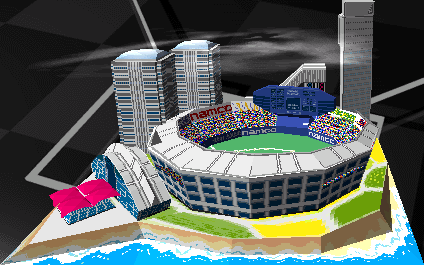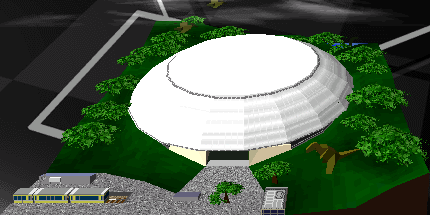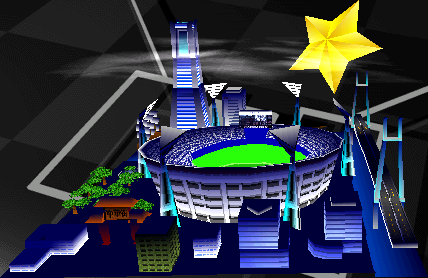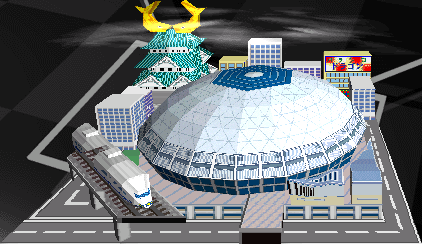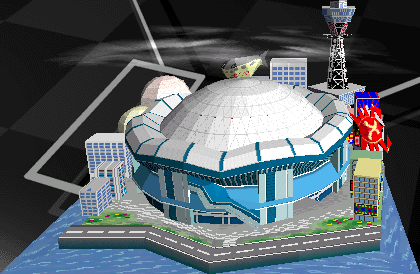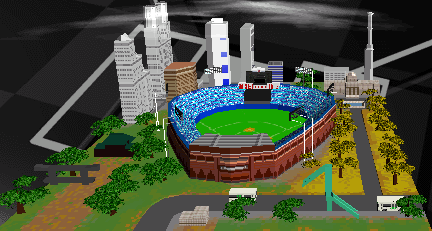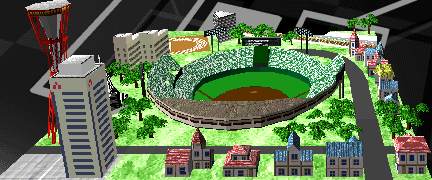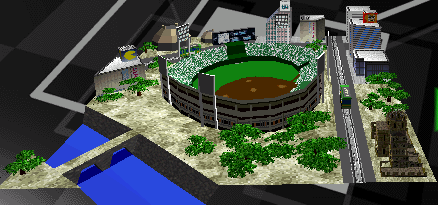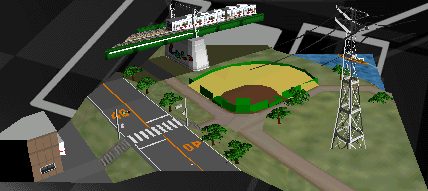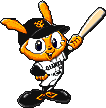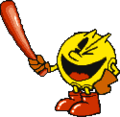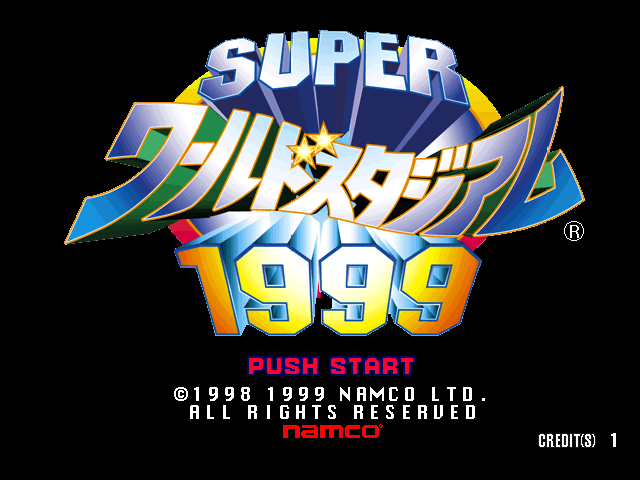
Once you have inserted a coin into the cabinet of Namco's Japan-only 1999 baseball arcade game Super World Stadium '99 the text of "PUSH START" will appear upon that screen (much like its ten predecessors, it allows two players to play on one credit); regardless of which Start Button you press, the game will proceed to a menu, from which you will have 80 seconds to select one of three new three-script texts: 1-ri de play (1人でPLAY), which means "play by one person", 2-ri de play (2人でPLAY), which means "play by two people", and tōnamento (トーナメント), which means "tournament" (also, if the arcade operator has set the "FAVORITE TEAM" option to "NONE" which is the default setting it will display the flags of the Central and Pacific Leagues on the left and right sides of the screen, but if he has set it to any of the twelve real-life teams, it will display two of the selected favoured team's flags on the left and right sides of the screen). The game will now proceed to the final team selection screen - and that timer at the top of the screen will continue counting down as you to select one of the thirteen returning and five new teams by pushing the joystick up, down, left and right, before pressing the first button to confirm your choice. As in all ten of the previous games, if you had only pressed that 1 Player Start Button, you will now have to select another team for that CPU to predetermine the behaviour of, but if you pressed that 2 Player Start Button, that second player will now have to pick another team to take control of (which, much like all ten previous games, is too bad if the first player happened to have chosen the team he wanted to take control of); twelve of the returning teams are also real, and their namings now reflect their 1998 lineups (even though, as with 1994, there was no WS game for that year). The USA All-Stars team (who were originally known as the "USA"), is entirely fictional, and was created specifically for Super World Stadium '96 - but the Central League, Pacific League, Namco Stars, Nikotama Gals and User Team were created specifically for this final game. The first two of these teams are comprised of a total of twenty-eight of the Central and Pacific Leagues' best players from their 1998 season, but the third and fourth ones are comprised of a total of twenty-three of Namco's most famous characters (however, the pitchers for the Namco Stars are merely named after five others).
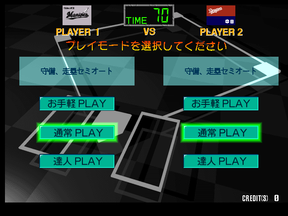
The game will then proceed to the new mode selection screen, as that timer up at the top of the screen continues counting down; both of the players will now have to select one of three new three-script texts otegaru play (お手軽PLAY), which means "handy play", tsūjō play (通常PLAY), which means "a normal play", and tatsujin play (達人PLAY), which means "guru play". If you pressed the 1 Player Start Button, the CPU will create the illusion of randomly selecting one of these modes, but it will always stop on the second one - and you will then have to select one of two more new three-script texts: Shiai kashi (試合開始) which means "start game", and jibun de kimeru (自分で決める) which means "decide for oneself"; if you select that first one, the game will automatically decide: which player's team is batting first, which of their pitchers has been selected, and what stadium the match will take place in, but if you select that second one, you will have to select one of three more new three-script texts: P1 senkō (P1先攻), which means "P1 batting first", omakase (おまかせ), which means "a random", and P2 senkō (P2先攻), which means "P2 batting first". Therefore, if you select that second one, the CPU will randomly decide which player's team is batting first, before proceeding to the team lineups screen - and all of the 225 players' names will have two Kanji characters next to their left side: yūgeki (遊撃), which means "short-stop", chūken (中堅), which, you may remember from the NS2 and NB-1 eras means "centre-field", sayoku (左翼), which means: "left-field", nirui (二塁), which means: "second-base", ichirui (一塁), which means: "first-base", uyoku (右翼), which means "right-field", hoshu (捕手), which means "catcher", tōshu (投手), which means "pitcher", and for non-Central-League teams, "DH", which means "defensive-half". The game will then proceed to the pitcher selection screen; you will now have to select one of your chosen team's five pitchers (again, if you had only pressed the 1 Player Start Button, the CPU will create the illusion of randomly selecting one of its team's pitchers to predetermine the behaviour of but it will always stop on the third one). If you cannot decide which pitcher to select (given that they no longer have the Kanji characters hidari or migi or even the letters "L" or "R" next to their names), the omakase (おまかせ) option is again present which will allow the CPU to randomly decide which of your chosen team's pitchers is selected - and you will now have to select one of the game's twelve new stadiums for your match to take place in (the fourth of which was originally known as "Kōshien" from 1988-1993):
The second stadium was also originally known as just "Hillside" from 1995-1997, and the third one was also originally known as just "Dome" from 1991-1993; once you have selected one of them, its three-dimensional model will stop rotating and the screen will fade out. It will then fade back in on the left side of your chosen stadium and pan across to the right, while your two chosen teams' logos are displayed in the centre of the screen, with the text "VS" between them and the three-script naming of the stadium below them - and some of the stadiums feature advertisements for earlier Namco games such as Soulcalibur, Race On, Time Crisis, Ace Combat, Sky Kid, Tekken, X-Day, Motos, Genpei Tōma Den, Mappy, Yōkai Dōchūki, Xevious, Pac-Man, Pole Position, Knuckle Heads, Beraboh Man, Navalone and Mirai Ninja (however, in the NS2 era, the Urban Stadium featured an advertisement for SOS, and in the NB-1 era it featured three advertisements for Dig Dug, Great Sluggers and Outfoxies; also in the NB-1 era, the Hillside Dome Stadium featured an advertisement for Starblade, that Trad Stadium featured an advertisement for Pac-Land, and that Kaihei Dome Stadium featured four advertisements for Ace Driver, Galaga, Mach Breakers and Midway Games' first unauthorized Pac-Man sequel Ms. Pac-Man). The match will then start up for the final time.
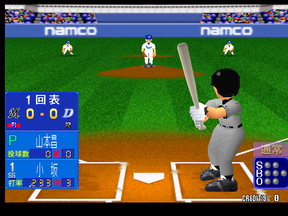
The view will now change to a shot of the centre of the stadium's field, as the No. 1 of the first player's chosen team steps up to the plate and the match's statistics appear on the opposite side of the screen to which he is standing; the scoring will now be displayed at the top of these statistics (with that batting team's initial underlined in red) under the number of 1 and the two Kanji characters of kai omote (回表), which means "front time". The statistics of the No. 1 from that first player's team will again be displayed in that bottom-left corner of the screen below that team's initial - and the statistics of the chosen pitcher from that second player's team will also be displayed in the bottom-right corner of the screen below the team's initial. The first player must use his joystick to position his batter inside that batting box, and the second player must push his joystick to the left or right to position his pitcher upon the pitcher's mound, then press his first button to throw the ball; he must now push the joystick to the left if he wants the ball to curve horizontally, down-left if he wants it to curve vertically, right to shoot horizontally, down-right to shoot vertically, down to fork and up to be a speed ball. If the other player's team's current batter failed to hit it, the Katakana text of sutoraiku (ストライク), which means "strike", will appear upon the screen, with the speed at which that ball travelled in kilometres above it, as one of the yellow lights next to the letter "S" on the left side of the screen turns on - and you both then have to repeat the pitching process, but if the other player's team's current batter fails to strike the ball again, that Katakana text sutoraiku (ストライク) will again appear on screen, with the speed at which the ball travelled in kilometres above it, as that second yellow light next to that letter "S" turns on. You will both then have to repeat that pitching process again, but if that other player's team's current batter fails to hit that ball once again, the Katakana text battā auto (バッターアウト) which means "batter out" will appear upon the screen (with the speed at which the ball had travelled in kilometres above it) as both the yellow lights next to the letter "S" turn off, a red light next to the letter "O" below it turns on and the other player's team's next batter is brought in; he'll have different statistics. The text boxes that were introduced in Super World Stadium '93 will also reappear - in the centre of the screen (as opposed to on the left side of it), but under the new Kanji/Hiragana text of kyō no seiseki (今日の成績): Heisatsu-da (併殺打), which means: "hitting double play", Hitto (ヒット), which means: "hit", Niruida (二塁打), which means: "two-based hit", Sanruida (三塁打), which means: "three-based hit", Honruida (本塁打), which means "home run", Gifurai (犠フライ), which means "sacrifice fly", Gibanto (犠バント), which means: "sacrifice bunt", Shikyū (死球/四球), which means "dead ball" or "walk", Uchifurai (内フライ), which means "fly in", Uchigoro (内ゴロ), which means: "grounder in", Sotofurai (外フライ), which means "fly out", Sotogoro (外ゴロ), which means "grounder out", Funige (振逃げ), which means: "shake relief", Shissaku (失策, which means "mistake", and Yasen (野選), which for a third and final time in this long-running series only means what it reads as.
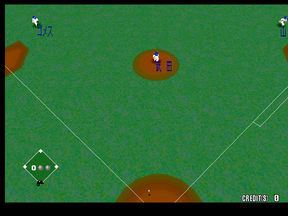
The first player must press the first button to make his batter swing and the second button to make him bunt; once he has struck the ball, the view will change to a shot of your stadium's field as it flies up into the air. If the ball does not land within the white lines, the umpires (of which there are six) will hold their arms up and the Katakana text fauru (ファウル), which means "foul", will appear upon the screen and it will be counted as a strike - it will also be indicated by one of the two yellow lights next to that letter "S" turning on once the view returns to the image you see above. Also, if the current batter hits the ball so hard that it flies out of the stadium, the Katakana text hōmu ran (ホームラン), which means "home run", will appear upon the screen, with the Katakana text 2 ran (2ラン), the different Katakana text 3 ran (3ラン), or the Kanji text manrui (満塁) below it; the increased score will then be displayed upon the screen (the teams are now represented by "larger" versions of their logos), as your team's players run around the bases. If the ball landed within the white lines after your chosen team's current batter hit it and one of the other players on your chosen team caught it as it fell back down to the ground, you will have to press the first button to make him throw it to one of the other players while pushing the joystick up and down to indicate which player you want him to throw it to; once you have done so, all the umpires will either hold their arms out and the Katakana text of sēfu (セーフ), which means "safe", will appear upon the screen if the player was safe, or they will hold their right arms up, and the different Katakana text of auto (アウト), which means "out", will appear on the screen if he was out (yet again, this will also be counted as an out, and it will be reflected by one of the two red lights next to that letter "O" turning on, once the view has returned to that screenshot you see above). The radar of the field, which still appears down in the bottom-left corner of the screen, shows the positions of that other team's players (they are indicated by the moving hats, which still match the colours of their own) - and when your team is batting and the other player's team is pitching, push your joystick up and press the first button to tag out a runner on the other player's team who is attempting to steal a base (they can, for the last time, still be seen in the windows, on the left and right sides of the screen). Once you have done so, the runner will run out of sight from the left side of the screen, as the other player's team's chosen pitcher throws the ball; once your team's current batter has struck on the ball, the view will again change to a shot of the field as it flies into the air, but the other player's team's chosen pitcher will then run off the pitcher's mound and onto the catcher's plate. You will now have to push your joystick to the left, then press your first button to make your chosen team's runner start running, then push your joystick up, and press your second button to make him run back again - and once three outs have occurred, the view will change to a shot of all 18 players running off the field of the chosen stadium, with a scoreboard at the bottom of the screen and a "DUE UP" list with the next three batters' names highlighted in yellow on the right side of the screen (or the left side of the screen, if it is the first player's turn to bat again). The match will then continue, for a final time in the series.
-
The Yokohama Baystars' larger logo.
-
The Chūnichi Dragons' larger logo.
-
The Yomiuri Giants' larger logo.
-
The Yakult Swallows' larger logo.
-
The Hiroshima Tōyō Carp's larger logo.
-
The Hanshin Tigers' larger logo.
-
The Seibu Lions' larger logo.
-
The Nihon Hamu Fighters' larger logo.
-
The Orix Blue Wave's larger logo.
-
The Fukuoka Daiei Hawks' larger logo.
-
The Osaka Kintetsu Buffaloes' larger logo.
-
The Chiba Lotte Marines' larger logo.
-
The Central League's larger logo.
-
The Pacific League's larger logo.
-
The Namco Stars' larger logo.
-
The USA All-Stars' larger logo.
-
The Nikotama Gals' larger logo.
-
The User Team's larger logo.
Ironically, the Namco Stars' larger logo, just like their normal logo and flag, depicts Pac-Man even though he is not an actual member of the team lineup.
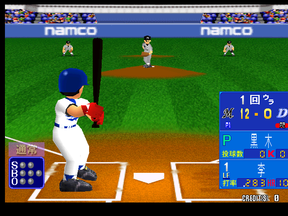
It will now be the first player's turn to pitch and the second player's (or the CPU's) turn to bat; the score display will also have the initial of the second player's team underlined in red as a result of this, and the text above will now read as the Kanji/Katakana of kai ura (回ウラ), which means "back time". The game continues until preset number of innings (depending on what that arcade owner has set "CONTINUE1" and "CONTINUE2" settings in the game's options menu to), have been played (you then have to insert another coin, and press either Start Button within 15 seconds, to continue your game each time). Once nine full innings have been played, or the losing team are down by ten runs in the bottom of any inning (however, if both of your teams have the same amount of runs after nine full innings have been played, your game will continue - and if either of the two teams scores twenty runs, the game will automatically be called), the Katakana text of gēmu setto (ゲームセット) which means "gameset" will appear upon the screen, before it fades to black. The Kanji/Katakana text Player 1/2 yūzā chīmu nyūdan (PLAYER1/2ユーザーチーム入団) will then appear at the top of the screen as the four Kanji (and Katakana in the case of the second) texts of senpatsu zen'in anda (先発全員安打), kōrudo gēmu (コールドゲーム), kyū renzoku datsu sanshin (九連続奪三振) and kantō shōri (完投勝利) fly into view from those left and right sides of the screen; they will then move up to the top-left corner of the screen, as your chosen team's chosen pitcher reappears in the centre of it and a box containing 80 Hiragana characters rises into view from the bottom of it. You will now have forty seconds to enter your name (up to 6 characters) by pushing the joystick up, down, left and right, then pushing the first button to confirm your choice - and if you select the button with the Katakana text for "Katakana" (カタカナ) on it, at the bottom of the box, the contents will change to 80 Katakana characters, and if you select the button with the two Kanji characters eisū (英数) on it next to it, the contents will change to 75 English characters. However, if you select the button with the two Kanji characters kūhaku (空白) on it, it will insert a "space" as a character; selecting the button with the English text "BS" on it will also clear the last character you have entered, selecting the button with the English text "CLR" on it will clear any characters you have entered, and selecting the button with the English text "END" on it will register that name you have entered. The Katakana text Namukosupōtsunyūzu (ナムコスポーツニューズ), which means "Namco Sports News", will then zoom into view in the centre of the screen before fading out to a shot of a female presenter named "Rena Yoshimoto" (this final World Stadium title does not have different reports for each stadium, or for when the player loses to the CPU in a 1-player game) sitting on a chair in a studio as the Kanji/Katakana text puro yakyū sokuhō (プロ野球速報), scrolls upwards on that left side of the screen. The view will then change to a shot of the result with the Kanji/Hiragana text Nihon no shiai kekka (日本の試合結果) up at the top of it; both of the chosen teams' names will be displayed in Kanji and Katakana below it with "VS" between them, along with the Kanji/Katakana text ōpun-sen (オープン戦), the name of your chosen stadium in all three scripts, and the two Kanji characters kankyaku (観客), with a non-consistent number and the Kanji character hito (人) next to it - and the amount of runs that both teams scored during each inning will then be displayed below that, before those of the winning team are highlighted in yellow. A red circle with the Kanji character shō (勝) in it, which has the name of that winning team's pitcher next to it, and a blue circle which has the Kanji character fu (負) in it which has the name of the losing team's pitcher next to it will also be displayed below that, along with an orange circle with the letter "S" in it (which has the names of the two players who suffered the most strikeouts next to it), and the letters "HR" (which has the names of the two players who hit the most home runs next to it); the winning team's larger logo will also be displayed on the right side of the screen with the text "WINNER!" below it and the Kanji text shiai jikan (試合時間) will be displayed below that, with X jikan X bun (X時間X分) next to it (the "X"s being the number of minutes and seconds your game lasted for). You can now sit back and enjoy the ending (this was the only World Stadium title to feature one like that of a non-sports game), which shows the view cutting back to a shot of the aforementioned Rena Yoshimoto as the credits scroll past at the top and bottom of the screen, and the text "THANKS TO PLAY" and "PRODUCED BY NAMCO" scroll upwards on the left side of the screen (the screen will also fade out towards the end of this).
-
Name entry screen with Hiragana characters.
-
Name entry screen with Katakana characters.
-
Name entry screen with English characters.
-
Rena Yoshimoto hosting "Namco Sports News".
-
Example of a "Namco Sports News" report.
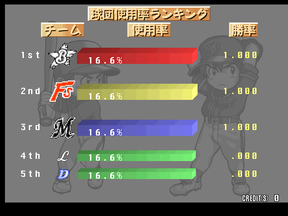
After the credits have finished, that text "GAME OVER" will appear on the screen, and the game will go back into attract mode (putting an end to the World Stadium series after eleven years) before cutting to a drawing of two baseball players with that Kanji/Katakana text kyūdan shiyōshotsu rankingu (球団使用率ランキング) at the top of it; three other Kanji/Katakana texts chīmu (チーム), shiyōshotsu (使用率) and shōritsu (勝率) will also be displayed below it as a list of all eighteen teams' initial letters, coloured bars indicating their usage rates, and winning percentages scrolls down into view from the top of the screen. The Orix Blue Wave still feature a "W" next to their "B" to avoid confusion with the Yokohama Baystars (formerly Taiyo Whales) - and the USA All-Stars (formerly just USA) also have a five-sided star instead of an initial letter to avoid confusions with the User Team (who were created specifically for this game).
